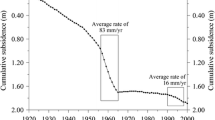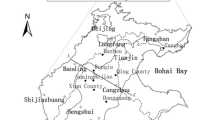Abstract
This study has been carried out under an International Cooperation Agreement between the People's Republic of China and Belgium. The final aim of the work is the detailed analysis of the geology, hydrogeology and engineering geology in the central area of Shanghai with an accurate simulation by a mathematical model of the subsidence occurring in this town and caused by groundwater withdrawals.
The detailed study of the Quaternary layers in the upper portion of 70 meters has revealed a complex geometry of the different units composed of clay, loam, silt and sand. The features of the deposits have shown variation of the sedimentation process from estuarine to fluviatile conditions as a function of sudden river avulsions and tidal changes.
Synthesis and compilation of all the hydrogeological and geotechnical tests madein situ on samples habe been completed. Many complementary tests (pumping tests, well-logging, pressuremeter tests, high and low pressure oedometer tests) have given the data needed by the mathematical model. On the basis of the results, hydrodynamic and geomechanical parameters of all the geological units have been determined.
Data relative to withdrawal or recharge of water in the zone have been introduced in the model. Compaction and subsidence measurements in different places allow the calibration of the model.
The Finite Element Method has been chosen using the LAGAMINE code developed at the University of Liege. This method allows to the use or very accurate spatial separation taking into account heterogeneities and facies variations of the layers. The simulation has comprised a 3D flow model giving as results the values and spatial distribution of the water pressures at each time step. Then, a coupled non-linear flow-compaction model has computed the subsidence as a function of time, taking the pressure variations in the aquifers as stress data. After the calibration procedure, simulations have been computed with «neutral» conditions (recharge ≥ pumping) and with “intensive pumping conditions” (pumping=1.3* recharge).
The computed additional compactions between 1989 and 2000 in the last conditions are from 1.4 to 7.9 cm. The more sensitive zones have been located and the pumping effect on the subsidence rate has been quantified.
Résumé
Cette étude a été réalisée dans le cadre d'un contrat de Coopération Internationale entre la République Populaire de Chine et la Belgique. Le but de la recherche est l'étude approfondie des conditions géologiques, hydrogéologiques et géotechniques de la zone centrale de Shanghaï et la réalisation d'un modèle mathématique permettant de simuler avec précision les phénomènes de subsidence qu'a subi cette ville suite aux pompages d'eaux souterraines.
L'étude détaillée des terrains supérieurs du Quaternaire a été réalisée jusqu'à 70 mètres de profondeur et a permis de distinguer une séquence de géométrie complexe composée d'argiles, de silts et de sables. Les caractéristiques de ces sédiments ont indiqué une sédimentation oscillant entre un régime estuarien et un régime fluviatile en fonction des déplacements du chenal et de l'estuaire du fleuve.
Après compilation et synthèse de tous les essais hydrogéologiques et géotechniques réalisésin situ et en laboratoires, une série d'essais complémentaires (essai de pompage, diagraphies, essais pressiométriques, oedomètres basse et haute pression) ont permis de compléter les données indispensables au modèle mathématique. Sur base des résultats, les caractéristiques hydrodynamiques et géomécaniques de toutes les formations présentes ont été déterminées.
Les données relatives aux quantités d'eau pompées et réinjectées ont été introduites dans le modèle et d'autre part, les tassements mesurés en différents endroits de la zone étudiée permettent de calibrer le modèle.
La méthode utilisée est celle des éléments finis, en utilisant le programme LAGAMINE développé à l'Université de Liège. Cette méthode permet une discrétisation spatiale très précise, tenant compte des hétérogénéités et des variations de faciès des terrains. La simulation a comporté un modèle écoulement 3D fournissant les valeurs et la répartition des pressions d'eau dans la zone modélisée à chaque pas de temps. Ensuite, un modèle écoulement-tassement non-linéaire et couplé a calculé les tassements en fonction du temps, en reprenant comme «sollicitation» les variations de pression aux aquifères. Après la phase de calibration, des simulations ont été réalisées en conditions «neutres» (réalimentation ≥ pompages) et en conditions de pompage intensif (pompage=1.3* réalimentation).
Les tassements calculés entre 1989 et 2000 dans ces dernières conditions sont de 1.4 à 7.9 cm selon les endroits. Les zones les plus sensibles aux tassements ont été localisées, les effets sur les tassements d'une éventuelle reprise du pompage ont été quantifiés.
Similar content being viewed by others
References
CORAPCIOGLU M.Y., 1984: Land subsidence, A state of the Art review in Fundamentals of Transport Phenomena in Porous Media, edited by Bear J. and Corapcioglu M.Y., NATO ASI Series, Series E: Applied Sciences no 82, pp. 369–444.
POLAND J.F., 1984: Guidebook to studies of land subsidence due to groundwater withdrawal, Unesco, Studies and reports in Hydrology.
SU H.Y. and HU Z.Z., 1980: A review of the studying situations on land subsidence in abroad, Shanghai Geology no 2, pp. 65–76.
Author information
Authors and Affiliations
Rights and permissions
About this article
Cite this article
Monjoie, A., Paepe, R. & He Yuan, S. Land subsidence in Shanghai (P.R. of China). Bulletin of the International Association of Engineering Geology 46, 5–7 (1992). https://doi.org/10.1007/BF02595028
Published:
Issue Date:
DOI: https://doi.org/10.1007/BF02595028




